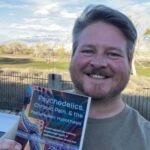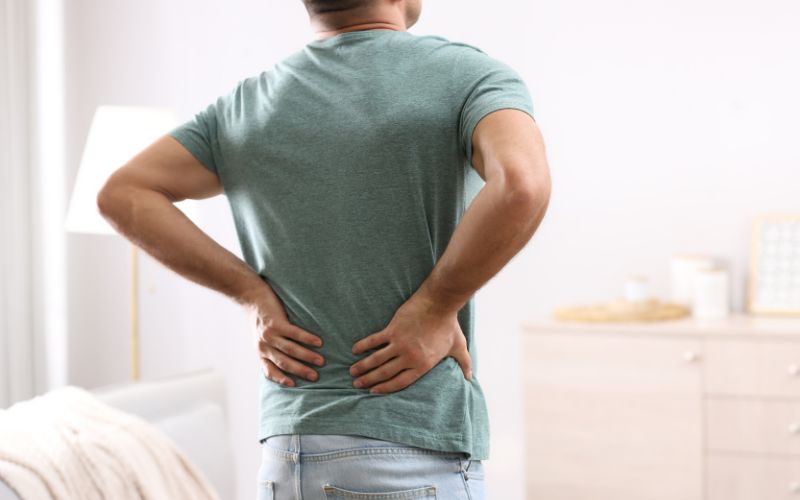“Since my journey began in July 2023 with mushrooms, I have not taken [opioids] for [complex regional pain syndrome] – I have not needed them. My Level 10 pain went to Level 0.”
These are the words U.S. Air Force Veteran Lynn Watkins wrote to me in an email on May 13. After psilocybin mushrooms helped her break a 20-year cycle of chronic pain and painkillers, she is understandably excited about the potential for psychedelics to bring desperately needed relief to others as well.
But not everyone is embracing the prospect of popularizing yet another psychoactive drug to treat chronic pain.
What’s the first thing that comes to mind when you think of using drugs for treating chronic pain?
For many people, the picture it paints in their minds likely isn’t all that pretty. It might be pharmaceutical companies profiteering off people in pain, or well-intentioned doctors inadvertently enabling destructive behavior. Maybe they see patients turning into addicts, and finally, addicts turning into criminals and homeless people.

If you’re from a big city, you might think of hopping over used needles when you walk your kid to the park. People from more rural areas might wonder why you now need to lock your doors in what used to be a perfectly safe small town not even 10 years ago.
Even worse, perhaps, you got hooked on painkillers after an on-the-job injury, or lost a loved one to drugs or drug-related violence.
So it’s understandable for people to feel apprehension when they see the most recent headlines about how psychedelics may be effective in treating cluster headaches, or when they hear that a new study is underway at UCSD for treating phantom-limb pain with psilocybin. It’s only natural to wonder whether we’re simply gearing up for what amounts to “The Opioid Crisis Part 2,” just switching out one drug for another.
Even our sequel-loving culture isn’t lining up to see that particular reboot.
A New and Different Story
That leaves us with the problem of untreated chronic pain.
What if using psychedelics for chronic pain, in reality, tells a completely new and different story? It might surprise you to know that some of the most researched possibilities for chronic pain don’t involve taking these medicines on a regular basis, and don’t come with the same risk of overdose or abuse. Moreover, it’s not even a new idea.
Let’s revisit both cluster headaches and phantom-limb pain.
The potential treatments for phantom-limb pain were first published in 1930, and then again in the 1960s. They usually involved one or two psychedelic sessions that often could put the condition into remission without the need for future applications.
Research on cluster headaches – commonly known as “suicide headaches” due to the severe pain they induce – suggests that two relatively small doses of psilocybin taken a few days apart, when used at the proper time, can potentially stop that cycle of headaches in its tracks for many sufferers. Repeated treatments may not be needed until the next cycle starts. That could be as much as a year later. (You can learn more from the advocacy group Clusterbusters, or from Joanna Kempner, Ph.D., author of the new book “Psychedelic Outlaws,” which covers the characters and conflicts involved in discovering and developing psychedelics as treatments for chronic pain.)
These are just two of many exciting possibilities for chronic pain.
But why are people looking to psychedelics for relief?
In short, our medical system is terrible at treating many forms of chronic pain. It’s not anyone’s fault. It’s more like an emergent property of a complex system, despite the fact that our medical system is full of well-meaning, competent people.
It’s even possible that our society wouldn’t have been so vulnerable to The Opioid Crisis in the first place if our medical system was more effective at treating more forms of chronic pain.
Why does our medical system have such a hard time treating such conditions?
Part of the answer is that it’s not all the medical system’s fault. It requires patients to take on a large share of responsibility, but affordable resources to educate them on how to exercise that responsibility are lacking. Western cultural expectations often place an unreasonable burden on doctors to fix something once it already has gone wrong, in lieu of exercising individual responsibility as preventative care. I say all this as someone who suffered from chronic pain and made both of these mistakes for far too long.
Another facet of this failure is that chronic pain is a complicated problem with no one-size-fits-all solution.
Psychedelics and Pain Treatment
There are three major types of pain: nociceptive, nociplastic and psychogenic. Let’s zoom in on them:
- Nociceptive pain occurs when you injure yourself or have unhealed tissue damage.
- Nociplastic pain happens when the brain rewires itself, making pain a constant part of your experience.
- Psychogenic pain is caused by emotional or environmental stress.
In cases of long-term chronic pain, all three types of pain are often at work in some form or another.
The solutions are necessarily complex in nature and often require more one-on-one time and fruitless exploration to rule out what doesn’t work, meaning a higher cost than is permitted by many large medical systems. Most of my clients come to me saying something that they feel like they failed out of the medical system when trying to get treatment for their pain.
This article isn’t about me. However, in the interest of disclosing my bias, I must report that I also “failed out” of the medical system. I broke my back as a teenager and suffered from chronic pain for nearly two decades before a desperate experiment with psilocybin and posture therapy saved my life at a time when I was in such bad pain that I wanted to commit suicide.
I also must disclose my role in the psychedelic landscape. I am the creator of psychedelic-assisted posture therapy, or what I call “posturedelic therapy” for short. Posturedelic therapy is a technique for targeting many forms of chronic pain by combining posture therapy and other healing modalities with the psychedelic experience.

I’ve helped hundreds of people reduce or eliminate chronic pain using standard, non-psychedelic posture therapy. I developed posturedelic therapy to help people when standard posture therapy and everything else falls short.
My protocol is perhaps best-applied to people who have a history of injuries that simply never healed correctly, allegedly “age-related” pains and, of course, anybody with chronic pain resulting from poor posture. People with autoimmune disorders who have become sedentary as a result of pain also can benefit greatly, among other applications.
But what about people who have chronic pain originating from other sources?
Thankfully, there are people working on finding ways to target these kinds of chronic pain using psychedelics as well. Let’s look at what people from the many paths found in the psychedelic landscape have to say when comparing and contrasting the uses of both opioids and psychedelics for chronic pain.
Similarities and Differences
Court Wing is a co-founder of the Psychedelics & Pain Association, an advocacy group working to effect policy change regarding psychedelics for chronic pain. He also is the CEO of REMAP Therapeutics, a company that provides psychedelics services aimed at reducing chronic pain.
“In some conditions, psychedelics may cause the brain to reorganize long-term maladaptive pain signals back into normal healthy ones, relieving the person of pain,” Wing explains.
Wing has some great insights into the similarities and differences between opioids and psychedelics.

“Both opioids and psychedelics started as substances found in nature and humans have been using them for thousands of years for healing,” Wing says. “The pain relief that can be achieved with psychedelics has been studied much less than for opioids, but the research is growing rapidly, and the signals of efficacy are strong.”
But the important similarities stop there, according to Wing.
“Opioids come with the danger of overdose. The risk of dying from a psychedelic overdose is virtually zero – with essentially no reported credible overdose deaths from classic psychedelics (psilocybin, DMT, LSD, mescaline).”
And he’s right. While the New York Times recently reported that opioid overdoses fell for the first time in five years in 2023, the CDC reports: “From 1999-2021, nearly 645,000 people died from an overdose involving any opioid, including prescription and illicit opioids.”
That’s around the same number of people in my hometown of Albuquerque, New Mexico, and its outskirts, just gone.
The credible risk of fatal overdose from classic psychedelics is almost nonexistent, with Bridget Huber on MichaelPollan.com providing a deep dive into these kinds of risks for the interested reader.
When speaking to the potential for substance-abuse disorder, Wing says, “Opioids also have well-documented dependency and tolerance issues.”
But in stark contrast, psychedelics may even prove to be a valuable part of the solution to the opioid crisis.
“Some pain conditions and patients that suffer from them can find rapid relief much like opioids but without the risk of addiction that opioids can create,” Wing explains. “In fact, there is mounting evidence that psychedelics had ‘anti-addictive’ properties, as seen in studies for alcohol, nicotine, cocaine and opioid-use disorders.”
Psychedelics do, of course, come with their own set of risks. However, the vast propaganda campaign against the drugs of the counterculture movement in the 1960s and beyond was far more effective in spreading fear and misinformation than stopping the use of street drugs.
The Patient Perspective
Enter Lynn Watkins. Watkins, a veteran of the United States Air Force, has suffered from debilitating chronic pain for more than two decades.
Among her many diagnoses, she suffered from a condition known as complex regional pain syndrome (CRPS) Type 2, and it affected her entire body with constant, severe pain. Her pain was complicated by diagnoses of PTSD and major depressive disorder. Botched surgery and years of legally prescribed opiates had done nothing to improve her situation.
“For years, I’ve taken pain meds – none of which helped with the nerve pain that I had due to CRPS,” Watkins says. “I kept taking them in hopes they would help one day.”
That all changed last summer when she tried psilocybin mushrooms.
“Since my journey began in July 2023 with mushrooms, I have not taken those pain meds for CRPS – I have not needed them,” she says. “My Level 10 pain went to Level 0.”
Of course, she didn’t just eat some mushrooms and hope for the best. She followed Court Wing’s REMAP protocol under close professional supervision.
“The most exciting thing for me is, and this may sound silly, but seeing the reduced number of pills in my hand every morning, noon and night,” Watkins says. “I have been able to reduce or eliminate so many pills I took on a daily basis.”
On the difference between opioids and psychedelics, she adds: “Opioids numbed my mind, but not my pain. Psychedelics not only erased my pain, they opened my mind.
According to Watkins, a doctor had been directing her to take opioids every four to six hours every day, for years.
“After weeks of preparation with my coach/facilitator (Court Wing) and my psycho-pharmocology nurse (CJ Spotswood), I dosed three times over seven days,” she recalls of her initial psilocybin treatments. “After 20+ years of chronic pain and numerous mental-health issues, I was pain-free and no longer met criteria for PTSD or major depressive disorder. Since I have continued through the integration process, I am still amazed at my physical and mental well-being. I feel like time has been turned back 30+ years.”
Too Good to be True?
The prospect of medicines for chronic pain that might only need to be taken a handful of times yet may provide superior results –while also helping to treat opioid-use disorders – quite frankly sounds too good to be true. But if it is true, more research is needed to understand best how to leverage these qualities. Our society desperately needs this, and we need it as quickly and as safely as possible.
But we still haven’t addressed those other risks I mentioned earlier. What exactly are they?
Are people really likely to jump off buildings because they think they can fly? What about the infamous LSD flashbacks?
Bidget Huber’s article is a great resource for a digestible deep dive into such topics. But there’s also plenty of research from the academic world.
Take, for instance, a study published in 2022 by Anne Schlag in the Journal of Psychopharmacology titled “Adverse effects of psychedelics: From anecdotes and misinformation to systematic science.”
Anne and her colleagues concluded: “Our review shows that medical risks are often minimal, and that many – albeit not all – of the persistent negative perceptions of psychological risks are unsupported by the currently available scientific evidence, with the majority of reported adverse effects not being observed in a regulated and/or medical context.”
So it’s all good then, right? Well, perhaps there’s still more to think about.
Payam, a psychedelic somatic internal family systems practitioner, provided a perspective that many may find surprising. (For personal reasons, he asked that we only share his first name.)
“I see a cultural trend toward treating these medicines like traditional Western medicines, where we have a diagnosis and expect the pill to do the work,” Payam asserts.
In a video chat, Payam expressed concern about ensuring that we maintain integrity with the training of facilitators as demand for these kinds of services increases.
“Say it’s a few years in the future, psychedelics are legal and we have a patient suffering from both an existential fear of death and chronic pain resulting from late-stage pancreatic cancer.” This is a plausible case. Easing suffering in these kinds of cases is certainly an area of intense interest for researchers.
“The problem is, no matter how good of a screening we do beforehand, it is impossible to know the extent of what kinds of suppressed traumas may have accumulated over that person’s life. We can set intentions with what we’d like to get out of a psychedelic experience, but we can’t control what bubbles to the surface once the medicine has been taken and we hit the mat.”
To be clear, Payam isn’t arguing that we shouldn’t use these medicines. “Practitioners need to know how to handle these kinds of situations,” he clarifies.
And that’s one of the key challenges: the fact that psychedelic healing can look a bit different than what we’re accustomed to in traditional Western medicine. To illustrate his point, Payam referenced the clinical-trial experience of Court Wing.
As Wing explained on my podcast last year, he participated in a psilocybin trial for treatment-resistant depression, during which Wing experienced relief not only from his depression but also spontaneous relief from chronic pain.
However, Wing’s leg shook so violently in the process that the people supervising his psilocybin session wanted to administer medication and take him to the hospital for treatment. Wing, given his background, refused. He insisted that what was happening was good for him and insisted that it be allowed to play out.
The next day, Wing’s depression and chronic pain were gone and still are to this day, according to Wing.
“If the people running the study had been allowed to intervene when Court started shaking, he might still be in pain today,” says Payam.
Payam is right: That result could have been sabotaged by well-intentioned yet ultimately insufficiently skilled facilitation. Fortunately, in this case Wing experienced relief, and it proved to be a good learning opportunity for those facilitators.
But it could have gone another way. Still being in pain and still being depressed isn’t the only risk of botching such an opportunity, at least as Payam sees it.
“If that healing process of energy release had been interrupted, it could have presented as new physical symptoms, made his depression even worse or introduced a new trauma with an unpredictable outcome,” Payam asserts.
He is further worried that a failure to properly train facilitators could one day lead to unjust backlash against psychedelics themselves, rather than the techniques used to administer and facilitate them. His concern is that this backlash would result in a big step backward after fighting so hard to gain ground in this battle.
The Future of Psychedelics and Chronic Pain
As psychedelics such as MDMA and psilocybin gain momentum toward an eventual rescheduling by the DEA because of mounting evidence for their efficacy in treating mental-health conditions, we run a very real risk of failing the tens of millions of Americans who suffer from chronic pain on a daily basis. This failure may appear in multiple ways.
It could look like being left out of the conversation surrounding policy almost entirely in favor of focusing on treating mental health. It might be failing to train facilitators on how to handle unusual aspects of what psychedelic healing can look like.
It might be a failure to properly fund research into medicines that not only can prevent people from needing traditional painkillers but also can reverse many of the worst physiological effects of opioid withdrawal.
Our society is so worried about the possibility that psychedelics might become The Opioid Crisis Part 2 that we’re ignoring the very medicines that could prove to be one of the most effective tools in healing our nation of the tragedy The Opioid Crisis has become.
Additionally, practitioners like myself won’t stop helping people find their own paths to healing simply because the laws in one place have yet to yield. Maintaining such restrictions only forces us to offer our services outside the country, which restricts access based on economic standing and exports not only psychedelic tourism dollars but also many of the best people with the skills necessary to train the army of psychedelic facilitators our trauma and pain-riddled culture is likely to demand in the future.
But that’s a story for a different day.
Today, the potential of psychedelics to revolutionize chronic pain treatment cannot be ignored. Joanna Kempner, the author of “Psychedelic Outlaws,” sums it up well: “Psychedelics do have risks, but, thankfully, addiction and fatal overdose are not among them.”
“Given the accumulated evidence that psychedelics are effective for certain forms of pain, and given their relatively safe side-effect profile, it makes sense to invest in researching their potential,” Kempner continues. “In the meantime, it’s time to pass drug policies that prioritize harm-reduction and public health, and that ensure pain patients receive the relief they so desperately need.”
 Jon Clark is an author, podcast host and psychedelic posture therapist. His latest book is “Psychedelics, Chronic Pain, & the Posturedelic Hypothesis,” available June 4 on Amazon. Follow “Posture Monster Jon” on social media.
Jon Clark is an author, podcast host and psychedelic posture therapist. His latest book is “Psychedelics, Chronic Pain, & the Posturedelic Hypothesis,” available June 4 on Amazon. Follow “Posture Monster Jon” on social media.

